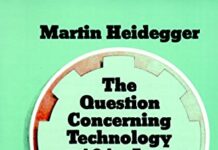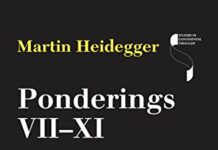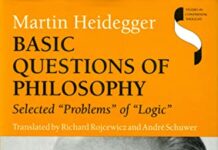
Ebook Info
- Published: 2002
- Number of pages: 150 pages
- Format: PDF
- File Size: 4.02 MB
- Authors: Martin Heidegger
Description
Identity and Difference consists of English translations and the original German versions of two little-known lectures given in 1957 by Martin Heidegger, “The Principle of Identity” and “The Onto-theo-logical Constitution of Metaphysics.” Both lectures discuss the difficult problem of the nature of identity in the history of metaphysics. A helpful introduction and a list of references are also provided by the translator, Joan Stambaugh.
User’s Reviews
Editorial Reviews: From the Inside Flap Identity and Difference consists of English translations and the original German versions of two little-known lectures given in 1957 by Martin Heidegger: “The Principle of Identity” and “The Onto-theo-logical Constitution of Metaphysics,” both discussions of the problem of identity in the history of metaphysics. A helpful introduction and a list of references are also provided by translator Joan Stambaugh. From the Back Cover Identity and Difference consists of English translations and the original German versions of two little-known lectures given in 1957 by Martin Heidegger: “The Principle of Identity” and “The Onto-theo-logical Constitution of Metaphysics,” both discussions of the problem of identity in the history of metaphysics. A helpful introduction and a list of references are also provided by translator Joan Stambaugh. About the Author Martin Heidegger (1889-1976) spent most of his career teaching at the University of Freiburg. His most prominent works include Being and Time, Discourse on Thinking, Identity and Difference, What is Called Thinking?, and Poetry, Language, Thought. Joan Stambaugh is a professor emerita of philosophy at Hunter College of the City University of New York. She is the author, most recently, of The Finitude of Being, The Other Nietzsche, and The Formless Self. Read more
Reviews from Amazon users which were colected at the time this book was published on the website:
⭐For the majority of people, it is the second of the two essays in this volume that will compel them to buy Identity and Difference. Both essays, however, are about the nature of metaphysics and given that the very possibility of metaphysics is a hot issue today, readers will likely find themselves benefitting by giving both essays a deep reading. The book also contains the original German of the essays, which makes the book twice as long; if one reads German then one will certainly benefit from this as it gives one the opportunity to study Heidegger’s nuanced and technical prose more closely.”The Onto-Theological Constitution of Metaphysics” has become something of a classic little work in the realm of post-modern religious and theological studies; however un/intentionally, Heidegger managed, with it, to open up the door for a return of the theological right in the middle of all philosophical discourse. Perhaps this is ironic, given that Heidegger was quite insistent that philosophy was fundamentally secular in its orientation. Or, perhaps this is intentional and serves to support the medieval Scholastic contentional the philosophy is the “hand maid” of theology and that reason finds its necessary completion in plenitudinous event of Revelation.How does one find or speak of the God that is beyond the “causa sui” (ie, self-caused) God of metaphysics? Where is the God that can be prayed to and danced before, worshipped and adored when metaphysics has turned the concept of God into nothing more than that of the unmoved mover? Heidegger does not seek to give a theological explanation here to this question, but simply to note that the problem exists. This does not mean the end of God, however, but necessitates a rethinking of the function and nature of metaphysics: we need to step out of metaphysics so that we might step back into its “active essence”.This is a work that complements Heidegger’s Introduction to Metaphysics well. Written in the post-war period, it witnesses to much of the confusion that was prevalent during the time and the urgent feeling that certain long-standing notions could no longer make sense of the late modern experience. Heidegger’s seeking a God beyond the idol-god of metaphysics has paved the way for much contemporary thought concerning the relation of philosophy to theology (and its most acute exposition has been given by Jean-Luc Marion in his fine book God Without Being). Identity and Difference is essential reading.
⭐Thank you!!
⭐”The problem of identity has been a basic philosophical issue since Parmenides. Parmenides stated it in the form: `thought and being are the same,’ with a radicality and a simplicity perhaps never again possible for later thinkers. Heidegger has pondered over Parmenides’ statement for years, returning to it again and again in his writings. Thus it came as no surprise to this translator when Heidegger stated that he considered Identity and Difference to be the most important thing he has published since Being and Time.”So says Joan Stambaugh, the translator of this excellent lecture course by Heidegger delivered at the University of Frieburg during 1957. In it he discusses the problems of identity, sameness, and relations of beings in Parmenides, Plato, on to the logic of Hegel. The latter part of the lecture is devoted to further metaphysical questions of the meaning of Being initially taken up in Being and Time, and finally concludes with remarks of onto-theology.This volume includes the German text which is helpful, however there is really only 74 pages of material here and the volume is $16 so it’s not a great bang for your buck, but the edition is as lovely as the content.
⭐This is a very short book composed of two essays (The Principle of Identity and The Ontotheological Constitution of Metaphysics). The actual text of the English translation is only around fifty pages which means the text is very dense and terse in formulation even by Heidegger’s standards. In order to understand what Heidegger is up to in this text you either have to already be in possession of a basic understanding of Heidegger’s later philosophy (especially Heidegger’s understanding of the ‘truth of Being’, ‘event of appropriation’, and the belonging together of thought and Being) or you will have to find a good secondary source that deals with this text (there is a short but enlightening discussion of the two essays in this book in a book by Otto Poggeler titled Martin Heidegger’s Path of Thinking). While this is a very interesting book the fact that it is so short does not make it a good stand alone text, or a good general introduction, to Heidegger’s late philosophy. I will attempt to summarize, to the best of my limited abilities, the two essays contained in this work. Anyone choosing to read my summaries should bear in mind that I am by no means an expert in Heidegger (yet) so these summaries should be taken as very provisional. If anyone spots what they consider to be errors in my interpretation please feel free to respond under the comments section of this review.In the first essay Heidegger attempts to think through the principle of identity (A is A) which is often considered the highest principle of thought. This principle is not, however, merely the highest law of thought, the principle to which all thought must conform in order to be coherent, it is also supposed to say something about the Being of beings, namely: every being is in such a way that it is identical to itself. If beings were not encountered in their identity with themselves something like science would not be possible. The principle of identity as it applies to Being is, therefore, a necessary presupposition for something like science. But is this the most profound understanding of identity? Heidegger does not think so. Heidegger believes there is a more profound form of identity which underlies our ability to encounter beings in terms of the identity they bear towards themselves. In order to elucidate this more profound notion of identity Heidegger turns to one of his favorite sayings of Parmenides “For the same perceiving (thinking) as well as being” (pg27). This is a strange translation but what is being asserted here is an identity between perceiving (thinking) and being. This identity is no longer the identity which we represent as a characteristic of the Being of beings since Being is one of the terms of this identity (it cannot, therefore, ground the identity). Heidegger interprets this identity as a belonging together of man and Being. Being only is within the clearing that man provides while man is only the response to Being. Heidegger believes that Being becomes present to man today primarily in the form of technology. Beings present themselves as what is manipulable or representable. The most difficult aspect of Heidegger’s later thought is that he no longer conceives this as a projection of man. In Being and Time Heidegger analyzed what he believed was an inherent tendency of Dasein to misunderstand the world in terms of merely present-at-hand things. This tendency could still be overcome, however, by providing a deeper ontology of Dasein and Dasein’s various modes of comportment. But the later Heidegger (the Heidegger after the turn) no longer believes that things are quite this simple when he writes, “Technology conceived in its broadest sense and in its manifold manifestations, is taken for the plan which man projects [which would be the standpoint of Being and Time]…Caught up in this conception, we confirm our own opinion that technology is of man’s making alone. We fail to hear the claim of Being which speaks in the essence of technology” (pg34). Reducing technology to a projection of man is itself part of the technological worldview which views everything in terms of its origin in the subject. Heidegger is attempting to understand how man is ‘delivered over’ to such a worldview which he calls the frame while not being the origin of this understanding. The frame, according to Heidegger, is “more real than all of atomic energy and the whole world of machinery” (pg35) but we are not aware of the frame because the frame itself determines the Being of beings as presence and the frame itself is not something that is present. It is not too difficult to understand the notion of an impersonal conceptual framework that determines our relation to beings (similar in its own way to Kuhnian paradigms). What is difficult to understand is Heidegger’s insistence that this frame is a claim of Being which man is delivered over to in what Heidegger calls the event of appropriation (I believe that some of the post-Heideggerians attempt to overcome what might be called Heidegger’s mystical understanding of the ‘sendings of Being’ by connecting these impersonal frameworks to more material structures like social practices and institutions and language). Heidegger does believe there is a way out of this impasse. If we are able to think technology and metaphysics in terms of the history of Being then we can pass onto an experience of the ‘event of appropriation’ which is the belonging-together of man and Being. We can, to some degree, free ourselves from the thinking which takes what is representable by the human subject as the measure of what is real and remain open to the mystery that is necessarily a part of every unconcealment of Being (since concealment belongs necessarily to every unconcealment). We can do this by thinking the more profound identity between thinking and Being which lies behind identity as a characteristic of the Being of beings. The goal of the first essay is precisely to think this more profound identity as the ‘event of appropriation’.In the second essay Heidegger attempts to determine the nature of metaphysics as onto-theo-logical thought which is itself grounded in the oblivion of the ontological difference (the difference between Being and beings). Metaphysics does think the difference between Being and beings but it thinks it in terms of the difference between ‘what-a-thing-is’ and ‘that-it-is’, or as Otto Poggeler writes, “the true world of the permanent what-it-is is distinguished from the apparent world of the vanishing and transitory that-it-is” (pg120). Metaphysics thinks the Being of beings in terms of constant presence which serves as a ground for the transitory existence of beings. Plato, for example, thinks of the Being of beings as Idea, that which remains identical beyond the transitory and fleeting world of sense-perception. But as Poggeler observes this winds up destroying the unity between beings and Being (which is why Platonism winds up positing another transcendent world of Being in contrast to the world of becoming) and this difference remains merely ontic (a difference between two beings rather than a difference between Being and beings). Heidegger is attempting to rethink the ontological difference in a way that does not lead to the positing of another, true realm of reality in contrast to the world that we actually live in (he is, therefore, carrying forward a project of Nietzsche, namely, the overturning of Platonism, though he attempts to overturn Platonism in a way that is not a mere reversal of terms which is what he thinks Nietzsche does). For Heidegger the Being of beings is not a true Being that is separate from beings; rather, “the Being of beings means Being which is beings” (pg64). Heidegger argues that the ‘is’ in this sentence must be understood transitively. In other words, not in the sense of identity (Being is beings in the sense that they are identical which would obliterate the ontological difference), but in the sense that Being becomes present in the transition to beings (as a sidenote: this terse discussion by Heidegger of the nature of the ‘is’ as transitive when it relates Being to beings is a key to understanding Heidegger’s discussion of Schelling and his relation to pantheism in his book on Schelling). This is a difficult thought to grasp but I think we can understand this thought with an example. The table that lies in front of me ‘is’, it has Being. But the table itself is not Being (it is not identical to Being, and this is the meaning of the ontological difference). On the other hand, Being (though different from beings) is not something that lies in another realm beyond the realm in which we live. The Being of the table is right in front of us; it does not reside in some inaccessible realm that we can only reach through thought (nor is Being a logical category which we can manipulate in thought). Being is the unconcealment of Being and is present as beings and yet it is not identical to beings nor is it a being (Lee Braver, in his book on Heidegger’s later writings, expresses this by saying that Being is an adverb rather than a noun; it expresses a way Being, or a how, rather than a substantive Being; in this work Heidegger argues it is “impossible to represent Being as the general characteristic of particular beings,” since, “there is being only in this or that historical character: phusis, logos, en, idea, energeia, substantiality, objectivity…” (pg66); these are the great epochal understandings of Being which determine the how of how we encounter beings; it is impossible to find a single, general concept of Being which would underlie all of these understandings of Being). This is what Heidegger means when he says that “the Being of beings means Being which is beings” (pg64) and that the ‘is’ in that sentence must be understood transitively. Being is always the Being of beings but it is also always a particular way of understanding beings which both reveals and conceals. This contrasts with metaphysics which attempts to think the Being of beings in the unity of what is general (ontology as the science of what is common to all beings, or, of being as being) and in the unity of the ground of Being (theology which conceives of the ground as God or the divine) (pg58). This is a circular dance according to Heidegger since we seek to ground beings in the general nature of Being and then wind up grounding the general nature of Being on a being (the highest cause). Metaphysics is lead into this circle because it follows the logos which is understood as the process of providing grounds, securing reasons, etc. (which ultimately leads to Hegel’s Science of Logic in which Being is conceived as this movement of thought itself, or thought thinking itself; and it should be pointed out that Hegel’s Science of Logic is the starting point of the second essay in this work). Heidegger, in other works, attempts to uncover a more original understanding of the logos as unconcealment which will move him away from metaphysics and logic (the giving of grounds, or the grounding of knowledge claims) towards poetry (the saying which uncovers the truth). It should be pointed out that metaphysics, for Heidegger, is inherently onto-theo-logy to the degree that it attempts to provide grounds for beings whether or not any particular metaphysical system winds up having recourse to an ultimate being in the sense of a self-caused being. Metaphysics is inherently onto-theo-logical whether or not it is explicitly theistic. The overcoming of onto-theo-logy is not, therefore, of necessity atheism but only the overcoming of a certain understanding of the divine in terms of a First Cause. But as Heidegger remarks, “Before the causa sui, man can neither fall to his knees in awe nor can he play music and dance before this god. The god-less thinking which must abandon the god of philosophy, god as causa sui, is thus perhaps closer to the divine God” (pg72). This opens up the possibility of a new understanding of religion and the divine which, I might add, remains largely immune to the criticisms leveled against religion by the new atheism since it does not posit a highest being as the ground of Being.In summary, this book is a very condensed discussion of some of the fundamental notions of Heidegger’s later philosophy (the frame, the ontological difference, the essence of metaphysics as onto-theo-logy, etc.). While it is not necessarily the best introduction to these aspects of Heidegger’s later thought due to its length and terse formulations it will prove a very enlightening text for anyone who already has some familiarity with Heidegger’s later philosophy.
⭐Extract from Agamben and Indifference, 2014. Thought it might help situate the importance of this book and explain why you should read it, but with great caution…In 1957 Heidegger published Identity and Difference, a work he saw as his most important since Being and Time, although as Agamben shows it is not stand-alone but part of a flurry of texts dealing with Ereignis. A significant feature of this slim volume is that it deals not with the opposing terms of the ontico-ontological difference but rather the very precondition of their opposition. He explains this with direct reference to the Hegelian dialectical methodology concluding on the fundamental difference between the Hegelian and Heideggerian dialectic:For Hegel, the matter of thinking is: Being with respect to beings having been thought in absolute thinking, and as absolute thinking. For us, the matter of thinking is the Same, and thus is Being—but Being with respect to its difference from beings. Put more precisely: for Hegel, the matter of thinking is the idea as the absolute concept. For us, formulated in a preliminary fashion, the matter of thinking is the difference as difference (ID 47).If we add into this two other conditions of difference posited by Heidegger in this text then we will begin to understand how, essentially, Heideggerian difference is the first real valorisation of indifference, Friedlaender and Schelling’s work notwithstanding.Previous to this statement Heidegger explains that in the formula of identity, A is A, one ought to concentrate not on the self-identity of the term in play, A, but in the manner in which one can posit this self-belonging: is. In saying that a thing is the thing it is one is essentially saying that the being of the thing is its belonging to its Being. “With this ‘is’, the principle tells us how every being is, namely: it itself is the same with itself. The principle of identity speaks of the Being of beings…To every being as such there belongs identity, the unity with itself” (ID 26). The formula A is A therefore means A is the same as A but not equal, for sameness is the total compound statement A belongs with itself which presupposes a degree of difference of A from itself to facilitate such a state of belonging. To belong with means to presuppose separation from. If identity were instead reduced to the formalism A=A then it would be so tautological as to be meaningless. That we can make a formal representation of identity means that identity contains a speck of disindentification within itself. Thus within identity there is always the difference between beings and their Being and man, he goes on to explain “is essentially this relationship of responding to Being, and he is only this” (ID 31). Or human being is the process of living self-reflexivity in self-conscious fashion. This being the case, identity is a question of difference, but not only is difference a part of identity—one cannot think identity without thinking the essential difference of an Also to a One, a part to its self-same identified whole—more fundamentally difference precedes identity as he says: “Whenever we come to the place to which we were supposedly first bringing difference along as an alleged contribution, we always find that Being and beings in their difference are already there” (ID 62). He concludes by explaining that metaphysics has always progressed by the manner in which it “represents beings in respect of what differs in the difference, and without heeding the difference as difference” (ID 70). Heeding the difference as difference is, as far as I can tell, effectively the first positive formulation of indifference proper in the history of Western thought, effectively because Heidegger never uses the term indifference in this respect.We can now see that Heideggerian difference is defined as the presupposition of difference as regards Being. Identity as such is difference of equality within the same. A being can differ from its Being, indeed must differ, but this difference is determined not by the difference between the terms but by the differential relationality of their differentiation. What constitutes ‘A is A’ is not the A, but how the relational ‘is’ operates. It is a similar point to Agamben’s own observation that it is the ‘and’ that is central to Being and Time, or how Being and beings can be said to sit together, and is part of a wider commitment on his part to what he calls syncategorematic thinking. The same logic is also to be found in Derridean différance which insists that in every identity there is a speck of alterity without which identity as identity could not be posited (indeed Derrida is primarily indebted to Heidegger for this observation without which deconstruction is impossible). Finally such a difference, difference qua differentiation or difference as such, must be said to be foundational. Difference precedes identity operating as its precondition. A maxim that also forms the basis of Deleuzian difference so that in one short phrase Heidegger effectively pre-disposes an entire generation of thinking around the philosophy of difference.All we need to add here is that in terms of how we have been formulating indifference, it is clear that although he never says it, when Heidegger uses difference, what he means is differentiation as such and thus he refers to second order, Hegelian indifference. Thus Heideggerian difference is the isolation of the centrality of indifference to the thought of being, and the negation of the Hegelian dialectic which posits difference (indifference) only so as to overcome it with the identity of the absolute concept as the perfect unity of beings and thought. And in as much as all modern continental philosophy is a response to the Hegelian-Heideggerian dialectic, that is a dialectic of dialectics, indifference is a foundational element of modern thought.
Keywords
Free Download Identity and Difference in PDF format
Identity and Difference PDF Free Download
Download Identity and Difference 2002 PDF Free
Identity and Difference 2002 PDF Free Download
Download Identity and Difference PDF
Free Download Ebook Identity and Difference




